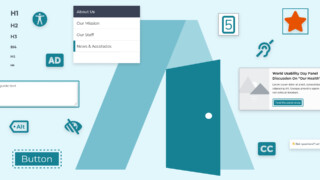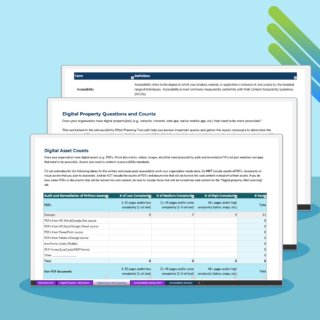Downloadable tool
Introducing the Digital Accessibility Effort Planning Tool
Fill out the form below to download the tool and view the associated introduction video.
3 Reasons why Digital Accessibility is important to your organization
If you are unsure if digital accessibility is relevant to your company or organization, simply put, it is. Not only is “equal access for all” the ethical thing to do but as Gartner said earlier this year, “Digital accessibility is no longer a choice; it’s a requirement.”
Just like with any initiative, a critical step towards success is to establish buy-in and support for digital accessibility at your organization. Here are just a few of the many reasons why eAccessibility should be important to you, your team, and your leadership.

Reason 1: eAccessibility expands your customer base
Without a focus on digital accessibility, your organization could exclude many potential audience members. This could be in the form of customers, users, constituents, fans, workers, or innovators.
It’s no surprise that as of 2023, 91.8% of the 330 million+ + individuals in the United States have access to the internet. According to the CDC, up to 1 in 4, or 27%, of adults in the United States have a disability. That’s not counting temporary impairments like a broken arm or contextual impairments like people who are driving, cooking, in bright sunlight, or in a noisy environment. This means people with disabilities represent a large market. Globally, over 2.3 billion people have a recognized disability, and their combined annual disposable incomes are estimated at $6.9 trillion.
Beyond the financial impact, if your organization has DEI (Diversity, Equity, and Inclusion), DEIA (Diversity, Equity, Inclusion, and Accessibility), or JEDI (Justice, Equity, Diversity, and Inclusion) initiatives, digital accessibility is a critical facet in meeting those goals. In other words, if your organization is not working to include people with disabilities, you may be inadvertently excluding a large number of people, which can impact revenue, company social responsibility initiatives, and brand perception.
Reason 2: eAccessibility improves your SEO
Without a focus on digital accessibility, your organization could be negatively impacting your SEO. It’s not just people that your organization could be excluding. Accessibility impacts machines, bots, and algorithms as well. Many digital accessibility best practices directly impact how search engines find and interact with your site and content. So, improving accessibility improves SEO, and not addressing accessibility negatively impacts SEO. For example, assistive technologies like screen readers look for cues like semantic headings and landmarks. So do search engines.


Government: Public entities that choose to provide services through web-based applications (e.g., renewing library books or driver’s licenses) or that communicate with their constituents or provide information through the Internet must ensure that individuals with disabilities have equal access to such services or information unless doing so would result in an undue financial and administrative burden or a fundamental alteration in the nature of the programs, services, or activities being offered. Another key concept to note is that government entities are typically held to stricter digital accessibility expectations. In 2021, the President released an executive order directing federal government organizations to embed accessibility into all their operations, including ensuring that their digital experiences are usable by all. –Levelaccess
Recently, more states have passed similar legislation for their state, county, and municipal government entities.
Reason 3: Digital accessibility minimizes your legal risk
Not conforming to digital accessibility standards can open your organization to legal consequences.
General: Even though the Americans with Disabilities Act (ADA) was established long before the rise of E-commerce, courts have interpreted Title II (Public services: State and local government) and Title III (Public accommodations: Private entities) as applying to web-based content and services. In fact, since the early 2000s, the U.S. Department of Justice (DOJ) has openly declared that ADA compliance includes access to websites that provide services, public accommodations, and/or other functions outlined in the Act. This means that although the language of the ADA does not explicitly mention the Internet, the Justice Department has taken the position that Title II covers Internet website access.
Companies and organizations: And people are taking action. Forbes is projecting that there will be over 4,000 ADA website lawsuits listed by the end of 2023, an increase of almost 200 over last year and almost double what was listed in 2018. – source
Law suites aren’t just targeting large companies….this year (2023), 77% of lawsuits were filed against companies that were under $25 million in revenue. And the majority of these lawsuits targeted e-commerce sites (84%). The second- and third-place industries for ADA lawsuits are the food service industry and the education industry. It should also be noted that the ADA applies to U.S. companies, but If your organization does business globally, there are other laws and regulations to keep in mind. The European Union, Australia, Canada, and others all have established compliance requirements.
Limina is here to help
If you have questions or are interested in working with Limina to improve or establish digital accessibility at your organization please feel free to contact us

Learn more about digital accessibility
Digital Accessibility is a necessary tool for growth, innovation, and inclusion. Learn more about Limina’s digital accessibility service and areas of expertise.
